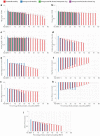Influence of body weight unloading on human gait characteristics: a systematic review
- PMID: 29925400
- PMCID: PMC6011391
- DOI: 10.1186/s12984-018-0380-0
Influence of body weight unloading on human gait characteristics: a systematic review
Erratum in
-
Correction to: Influence of body weight unloading on human gait characteristics: a systematic review.J Neuroeng Rehabil. 2018 Aug 8;15(1):73. doi: 10.1186/s12984-018-0414-7. J Neuroeng Rehabil. 2018. PMID: 30089522 Free PMC article.
Abstract
Background: Body weight support (BWS) systems have shown promise as rehabilitation tools for neurologically impaired individuals. This paper reviews the experiment-based research on BWS systems with the aim: (1) To investigate the influence of body weight unloading (BWU) on gait characteristics; (2) To study whether the effects of BWS differ between treadmill and overground walking and (3) To investigate if modulated BWU influences gait characteristics less than unmodulated BWU.
Method: A systematic literature search was conducted in the following search engines: Pubmed, Scopus, Web of Science and Google Scholar. Statistical analysis was used to quantify the effects of BWU on gait parameters.
Results: 54 studies of experiments with healthy and neurologically impaired individuals walking in a BWS system were included and 32 of these were used for the statistical analysis. Literature was classified using three distinctions: (1) treadmill or overground walking; (2) the type of subjects and (3) the nature of unloading force. Only 27% studies were based on neurologically impaired subjects; a low number considering that they are the primary user group for BWS systems. The studies included BWU from 5% to 100% and the 30% and 50% BWU conditions were the most widely studied. The number of participants varied from 1 to 28, with an average of 12. It was seen that due to the increase in BWU level, joint moments, muscle activity, energy cost of walking and ground reaction forces (GRF) showed higher reduction compared to gait spatio-temporal and joint kinematic parameters. The influence of BWU on kinematic and spatio-temporal gait parameters appeared to be limited up to 30% unloading. 5 gait characteristics presented different behavior in response to BWU for overground and treadmill walking. Remaining 21 gait characteristics showed similar behavior but different magnitude of change for overground and treadmill walking. Modulated unloading force generally led to less difference from the 0% condition than unmodulated unloading.
Conclusion: This review has shown that BWU influences all gait characteristics, albeit with important differences between the kinematic, spatio-temporal and kinetic characteristics. BWU showed stronger influence on the kinetic characteristics of gait than on the spatio-temporal parameters and the kinematic characteristics. It was ascertained that treadmill and overground walking can alter the effects of BWU in a different manner. Our results indicate that task-specific gait training is likely to be achievable at a BWU level of 30% and below.
Keywords: Body weight support; Gait characteristics; Rehabilitation.
Conflict of interest statement
Competing interests
Heike Vallery and Michiel Plooij have been and continue to be involved in the design and commercialization of body-weight support systems.
Publisher’s Note
Springer Nature remains neutral with regard to jurisdictional claims in published maps and institutional affiliations.
Figures






References
-
- Hornby TG, Zemon DH, Campbell D. Robotic-assisted, body-weight-supported treadmill training in individuals following motor incomplete spinal cord injury. Phys Ther. 2005;85(1):52. - PubMed
Publication types
MeSH terms
Grants and funding
LinkOut - more resources
Full Text Sources
Other Literature Sources
Medical

